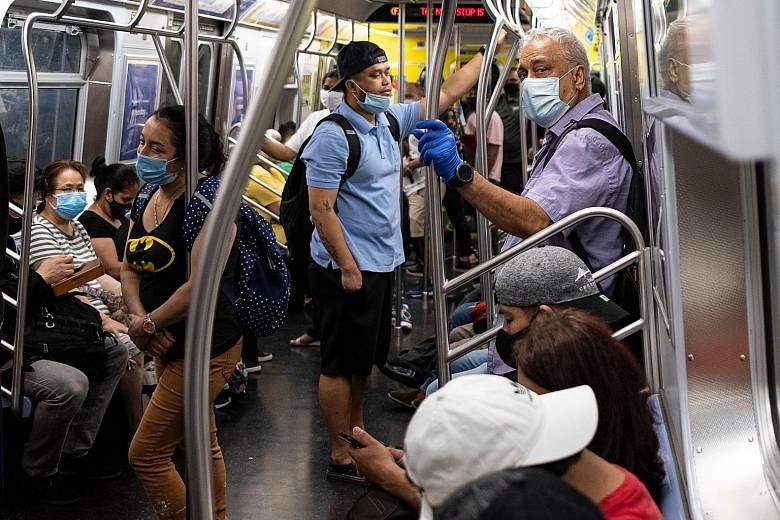NEW YORK • Many New Yorkers are avoiding the subway, fearful of jostling with strangers in crowded cars.
Masks and social distancing are essential, but good airflow is also key to reducing the risk of exposure to the virus.
The subway's ventilation system moves air within train cars more efficiently than restaurants, schools and other indoor settings, according to aerosol experts. But it is not a guarantee to protect against the virus.
Here is how the system works.
At any given moment, 75 per cent of the air a person breathes in a subway car is recycled. The rest is pulled in from outside.
Air is constantly sucked up through vents, cooled and filtered before being pushed back through ducts that span the ceiling.
At the same time, outside air is pulled into the system, combined with the existing mix and released into the car through the duct panels, which span the ceiling.
Continuous airflow through the vents helps limit viral particles from building up inside a car and infecting people as they inhale.
Most subway cars have two ventilation units at either end, which help fully replace air in the car with outside air about every three minutes and 20 seconds on average.
Inside the units, fans pull the air through filters and cooling coils. The filters work to block large and small aerosols before air enters the ducts.
But the filters do not catch everything - and some viral particles could slip past and get dispersed into trains.
The way the filters work is determined by their materials and shape. The subway filters have a wave design that increases their surface area, creating more opportunities to trap droplets.
-
75%
Proportion of air a person breathes that is recycled in a subway car. The rest is pulled in from outside.
-
3min 20s
How often air in a subway car is fully replaced with outside air on average.
The filters are made of fibres that force incoming air to change direction, trapping some particles as air is pulled through the filters.
Filters like these are rated by their ability to block large particles, also known as their minimum efficiency reporting value, or Merv.
Still, the subway's so-called air exchange rate - or how often recirculated air is completely replaced with fresh air - helps minimise the risk of coronavirus transmission for riders.
The recycled air on subway cars is replaced on average at least 18 times an hour, far higher than the recommended exchange rate for offices, which is six to eight times an hour, or classrooms, which is three to four times an hour.
Even with a relatively high exchange rate, however, viral particles that slip past the subway system's filters could - based on ventilation patterns - circulate at least three times in the car over the course of several minutes.
While it is still unclear how much virus is needed for someone to be infected, coming into contact with a few viral particles may not make you sick. Still, the simulations underscore the importance of both good ventilation and passengers wearing masks: Without proper ventilation, those aerosols would stay aloft in the air and build with each sneeze or cough.
To help address that, the Metropolitan Transportation Authority, which runs the city's subway, is testing out new ultraviolet technology that could be installed inside trains to kill viral matter in the air.
This would prevent any viral particles a sick rider exhales from being recirculated through the ventilation system.
New York state has also required subway riders to wear face masks, and the state's transit agency has begun offering free masks.
Public health experts say that the high air exchange rate and widespread mask usage on the city's subway sharply reduce the chances of a so-called super-spreader event on trains.
Only 20 per cent of New York's 5.5 million weekday subway riders now use the system.
The health experts caution that if more people begin riding the subway, pushing crowding closer to pre-pandemic levels, the ability of the system's ventilation to lessen the risk of viral transmission diminishes dramatically.
NYTIMES

